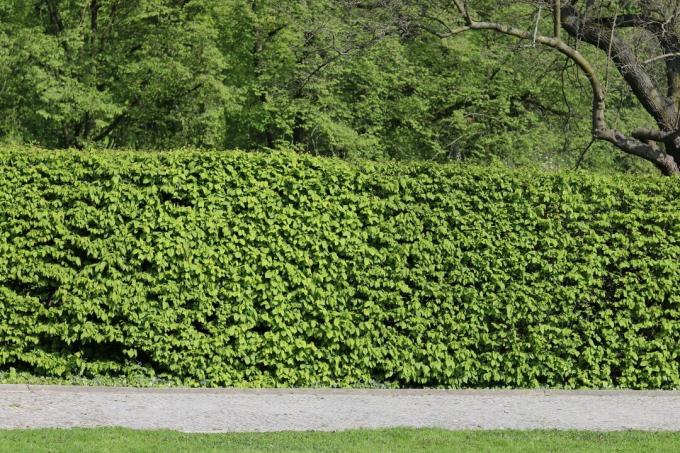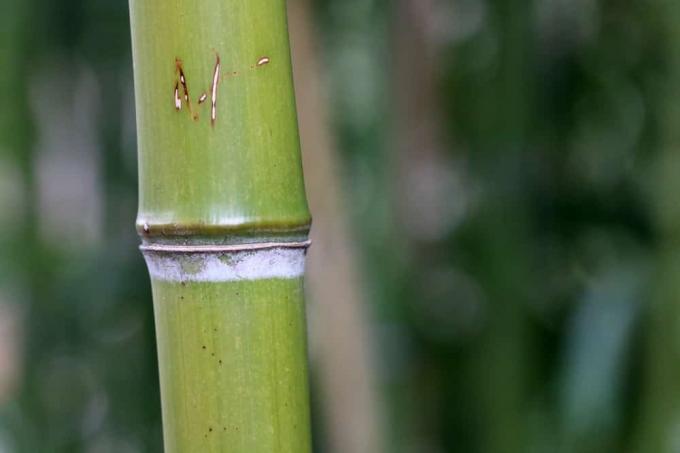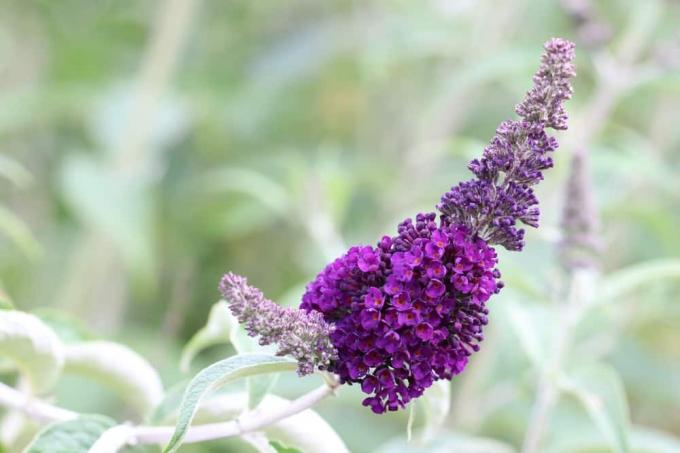

Table of contents
- Hedges need maintenance and are not suitable for every location
- Deciduous or evergreen - sweeping leaves or privacy even in winter?
- Yew, Cypress, and Holly: Some plants are poisonous
- Better to plant native plants
- Tips for speed readers
- Other advantages and disadvantages of hedges
- Advantage: privacy and noise protection
- Disadvantage: Need to cut back
- Advantage: improvement of soil fertility
- Disadvantage: casting shadows
- Pros and cons: Increased evaporation
There are many different ways of visually delimiting, structuring or spatially designing a garden or property. Trees are a possibility, fences and walls. Hedges are popular design elements, they often have practical benefits, but they also have disadvantages.
Hedges need maintenance and are not suitable for every location
Most hedge plants want humus-rich, moist soil, need sun to partial shade and do not do well in barren terrain. It is therefore first of all a question of the location, whether a hedge can be planted or not. Like all plants, hedge-forming shrubs and trees also need care, they have to be in a dry place summer weeks, want to be fertilized now and again, have to be once or twice a year be cut back. If you want to have a shapely and well-groomed hedge, you probably use scissors more often. Hedges are natural habitats. They attract animals: insects live in and on the leaves and flowers, birds feed on the fruits of the hedge and the insects that live in them. Maggots, worms, beetles and other small animals populate the branches, trunk and root area. They in turn attract predators – bats and birds, but also voles, hedgehogs, martens, polecats, rats and other animals feed on them.
If the hedge is close to a window or a door, it is likely that one or the other animal will get lost in the house, because the animals' range of action is sometimes quite large. Another disadvantage of hedges is that, unlike fences and walls, they can attract pests that also like to infest neighboring plants. This includes fungal infections and aphids, but also wasps that lay their eggs in the leaves. It takes a lot of care to keep the hedges healthy and, in the event of an infestation, to contain the spread of infection.
Deciduous or evergreen - sweeping leaves or privacy even in winter?
Hedges are a natural privacy screen that is relatively durable and inexpensive - that's where the benefits of the hedge lie. However, some hedges are more work than others: Evergreen hedges look beautiful in summer and winter, but are sometimes sensitive to frost and take away a lot of light at any time of the year. In summer it might still be nice to be in the shade of a green (hopefully not too prickly) hedge sit - in winter it can be annoying when the last bit of daylight is taken away by the dense hedge becomes.
Deciduous hedges can grow dense enough to offer at least marginal privacy through the branches even in winter. Common beech and hornbeam come into question. However, the trees shed their leaves in autumn: the leaves have to be swept up, otherwise they will soon be quite high and even pose a danger on sidewalks and streets. Sweeping the leaves once is not enough, because the leaves fall over several weeks. Animals that live in the hedges cause further pollution. Bird droppings and insect debris will soil nearby parked cars, near house walls, and possibly anything near the hedge. That can be quite annoying. However, this problem also affects evergreen hedges.
Yew, Cypress, and Holly: Some plants are poisonous
There are an incredible number of trees and shrubs that grow dense enough to serve as a hedge. Not all of them are native to Germany, and not all are non-toxic. Anyone who has children or lives in the vicinity of a school, kindergarten or after-school care center should think twice about which plants are really suitable as a hedge on the property line. Because poisonous plants can be dangerous, not all trigger harmless headaches. Some plants, when distorted, are deadly. These include among the native hedge plants the yew and the boxwood, among the introduced and widespread species of arborvitae, holly, cypress, the cherry laurel. On the other hand, privet and beech are non-toxic. In autumn, the common beech provides beechnuts that are edible but contain small amounts of hydrocyanic acid. A handful of beechnuts can already cause discomfort. The leaves of the beech are also edible. The hornbeam, which actually belongs to the birch family, is also completely non-toxic and native - this also applies to the field maple.
Better to plant native plants
Of course there are some exotic plants that are firstly very hardy and secondly beautiful as hedges. If these species are not native to Germany, however, planting them as a hedge in the garden is a disadvantage, because there is always a risk that the plants will spread uncontrollably. Especially with a larger hedge population, it is not possible to control whether seeds are blown away by the wind, carried away by animals, where they germinate and whether they threaten native species. That sounds very far-fetched at first, but in fact plants are commercially available and already are brought in, which due to German nature conservation regulations is actually not so easy to keep outdoors may be.
For example, thujas and cypresses, holly, cherry laurel and firethorn are not native. However, the firethorn is now planted as a bird habitat, thanks to its thorns and the dense growth provides safe nesting sites that cats, martens and other predators cannot reach can. Firethorn berries are edible for local birds, so the hedge is a valuable winter feeding ground. Various species of barberry (a hardy but only deciduous shrub) are at home in Germany and also provide a habitat for birds and insects.
Tips for speed readers
- Most hedge plants need humus-rich, slightly moist soil and partially shaded to sunny locations.
- Hedges need to be trimmed once or twice a year (depending on growth), possibly more often.
- In dry summer weeks, the plants have to be watered and fertilized from time to time.
- Hedges attract animals that are desirable on the one hand (environmental protection), but on the other hand cause pollution. Insects in particular can become annoying.
- Deciduous hedges don't take away too much light, but foliage needs sweeping in the fall. Evergreen hedges take up space even in winter when there is little light and shade the windows behind them.
- Poisonous hedge plants are a source of danger in gardens with children that can have fatal consequences.
- Non-native hedge plants can spread undesirably and become an ecological problem.
- Advantages: Hedges are inexpensive and durable, provide habitat for native animals, contribute to climate protection and sometimes provide food.
Other advantages and disadvantages of hedges
Advantage: privacy and noise protection
Red deer, fallow deer and small game are increasingly looking for cover behind hedges in a structurally poor agricultural landscape. This visual protection is also perceived as positive by people, for example in settlement areas and in "buffer zones". Richly structured hedge landscapes are often associated with positive values such as "beautiful", "idyllic" etc. described, regarded as ideal and gladly used for recreation. Several hedges in a row on traffic roads also offer good noise protection. On the other hand, it should be viewed critically that game scurries from cover to cover and therefore often becomes a victim on roads that are green with hedges.
Disadvantage: Need to cut back
Hedges are no longer used for firewood today. This eliminates the need for pruning for rejuvenation. The care of hedges must therefore be carried out consciously today, since overaged hedges in the sense of the biotope network only offer a home to a significantly smaller number of species. If the hedge, and in particular its edge, is not cared for regularly and professionally, it will develop into a series of large trees. The species-rich border becomes bushy without care; larger trees are growing, which are often delimbed because of adjacent uses: the edge disappears.
Advantage: improvement of soil fertility
Due to the fall of leaves and dying perennials along the edge, the soil around the hedge is enriched with raw humus in autumn. The ratio of the two elements carbon and nitrogen is improved in favor of the former and thus leads to improved nitrogen fixation. On grassland sites, however, farmers often fear that leaf fall in autumn could suppress forage grasses and promote a change in plant communities towards more herbs. In the long term, the broken soils, locations of former hedges, resulted in higher soil fertility than on adjacent arable land.
Disadvantage: casting shadows
Casting shadows leads to a distinction between the sun-exposed and the shady side. Less warming on the shady side is also often rated as negative, since grain ripens more slowly there than on sunny areas. This problem can be avoided in near-natural farming by caring for the weed border and by creating field margins.
Pros and cons: Increased evaporation
Trees and shrubs evaporate more water (botanically: transpiration) than herbaceous vegetation in summer Temperature maximums lowered during the day and temperature minimums due to reduced radiation and latent heat raised; at the same time causes the higher suction tension Hedge (woody plants) a water shortage for adjacent vegetation. Arable crops are affected if there is no hem. The development of a dry hem is favoured.
 garden editorial
garden editorial I write about everything that interests me in my garden.
Learn more about hedges

Hornbeam hedge: 17 tips for care
Hornbeams (Carpinus betulus) are most commonly used as topiaries or hedge plants. They are actually not beeches at all, but belong to the birch family. The hornbeam is very robust, easy to care for and, in contrast to the common beech, not poisonous.

How fast does bamboo grow? | Information about growth
In domestic gardens, bamboo is usually used as a privacy screen or as a decorative solitary plant. The rapid growth, which can reach several cm a day, is impressive. It depends on the bamboo variety, care and the prevailing microclimate.

How fast does cherry laurel grow? | accelerate growth
The cherry laurel is a fast and densely growing tree. After planting, it usually only takes a few years for the young plants to grow into a tall, dense and evergreen hedge. In addition, growth can be accelerated by additional precautions.

Creating a mixed colorful hedge: 9 ideas for a mixed hedge
If you don't like it monotonous, you can also create a mixed hedge instead of a hedge from a single, evergreen plant species. There is a wide range of colorful hedges to choose from. There are special flowering hedges, ones for birds, scented ones, or for insects and butterflies.

Yellow cypress | 9 tips for care, pruning & growth
The yellow cypress is one of the most common hedge plants in our gardens. No wonder: it combines a great look with an opaque growth. How to properly care for them, cut them and generally promote their growth is here.

Thuja brabant turns brown or yellow: what to do? 8 common causes
When Thuja brabant turns yellow or brown, various factors can be responsible - but care mistakes are often the trigger. We reveal which factors are involved and how they can be counteracted.
